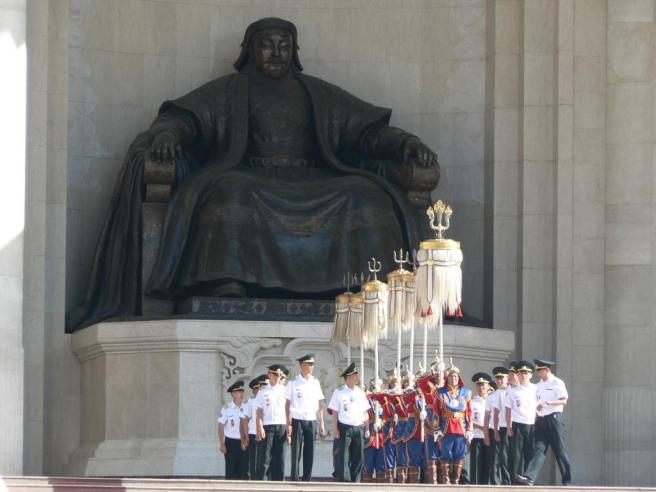“Remember, you have no companions but your shadow”
– Genghis Khan, 1st Khagan of the Mongol Empire,Khan of the Mongols and King of Kings ( 1162-1227 )

In the 13th Century, Genghis Khan established the Great Mongolian State and initiated the Nine White Banners as symbols of ceremony.
Mongolia’s Nine White Banners or, “Yoson Kholt Tsagaan Tug” was composed of nine flag poles decorated with white horse tail hairs hanging from a round surface with a flame or fork-like shape on the top.
The Nine White Banners was a peacetime emblem used exclusively by the Mongol Khans in front of their yurt. The Mongolian people have been honoring the banners ever since.
The central banner was larger in size than the rest and was placed in the center of the other eight; The Nine White Banners are made up of the tail hair of a thousand stallions from each of the provinces in the country.
The white and tawny colors, as well as the horse hair are symbolic of the power and strength of the state.
Eight 2.62 meter high white banners are placed around a larger white banner, measuring 3.62 meters.
The tops of the banners are called ‘gilbers’ symbolize the past, present and future, while the spire crowning the bigger banner represents the growth and pride of the state.
Interestingly, the banners are cleaned only with rainwater because ancient Mongolians used to pray to the sky and believed that water produced from the heavens was clean and pure.
The Nine White Banners came into renewed significance in Mongolia after democracy was adopted in the early 1990s as a symbol of the traditional Mongolian state, replacing the previous communist red flags.
The banners are usually stored on the third floor of the Government House, but every year they are carried out to the Central stadium for Mongolia’s National Naadam Festival.
Courtesy : The Mongolian tourist / pilgrim I had the honor of meeting, talking and knowing in Dharamshala ( Tibet in Exile ) Himachal Pradesh, India in 2005, too bad we lost touch as I was not very active on social media back in those days!
Further Reading :
10 Things You May Not Know About Genghis Khan
March of the Nine White Banners
In Pictures: The Naadam festival in Mongolia



Truly beautiful! These Altaic symbols remind us so much of some North American tribes (both US and Canada´s) First Nations´ as well! Thank you so much for sharing this with us, Kameng.
By the way, I have never liked throat-singing due to the extremely low pitch of these chants but I´ve found other types of Mongolian singing which remids us of both Tibetan and North American First Nations´. They are also producing some folk-based modern songs with light female voices which are most soothing, very much like their southern brethren Buddhist peoples´ songs.
A sample of one such new kind of soothing Mongolian songs
I copied this most enlightening comment from a Youtube user about this fantastic singer and her true culture
Kin Aisin-gioro5 wrote:
“She’s not inner Mongolian, she’s Mongolian from Qinghai Province which should be recognized as Hoshut Mongolian, one tribe of Oirat/Olot Mongol. Among all the Mongolians, they live close to Tibetan people, so their religion is most close to Tibetans, almost all Hoshut Mongolian are Tibetan Buddhists, including her, the girl singer, Daicin Tana.”
Inner Mongolia Song
LikeLike
Hi Alex,
Thank you so much for taking the time out and reading the article.
Yes there are similarities between the Native American Cultures and Tibetan Culture, I’m sure you are aware of The Land Bridge Theory, also known as the Bering Strait Theory or Beringia Theory?
The Land Bridge Theory proposes that people migrated from Siberia to Alaska across a land bridge that spanned the current day Bering Strait. The first people to populate the Americas were believed to have migrated across the Bering Land Bridge while tracking large game animal herds.
Settlement of the Americas
https://en.wikipedia.org/wiki/Settlement_of_the_Americas
Thanks for sharing the Mongolian song video. Do keep visiting the BLOG for more articles and feel free to share the articles and give your views on the same.
Regards
Kameng
LikeLike
Interesting info.
LikeLike
Hi Ranjeet,
Thank you so much for taking the time out and reading the article.
Do keep visiting the BLOG for more articles and feel free to share the articles and give your views on the same.
Regards
Kameng
LikeLike
Thank you !!! Mongolia always interested specially Chengiz Khan …beyond Gobi Desert !!!
LikeLike
Hi Namlee,
Thank you so much for taking the time out and reading the article.
Do keep visiting the BLOG for more articles and feel free to share the articles and give your views on the same.
Regards
Kameng
LikeLike